Schule für Diensthundewesen dr GST in Biesenthal near Berlin, 1956 The GST set up a school for service dog training in Biesenthal in Berlin, where the “Cadre development” should be carried out in the service dog industry, a. The circles and Districts should send members who are not only interested in the training of- dogs were trained, but were also “trained” in the political field. They Cadres should then be assigned to senior functions of the districts and districts of the GST, to penetrate the entire organization at all levels with trained personnel.
The idea was developed by the districts and districts, which should send the staff not quite seriously speaking. The GST complained about the lack of motivation and unsuitable candidates, those who were sent (Der Hund 6/1956), because “those who were sent thought there was a better To spend a vacation or to be able to train your dog for an exam at school”. The GST also organized the exhibitions/shows of the service and utility dog breeds. The first GST show took place in Dessau on 6.5.1956 with 300 service dogs, of which there were 160 German Shepherds alone.
The Section Service and Utility Dog Management (SDG) On 31.10.1961 the Section Service and Utility Dog Management (SDG) of the GST was transformed into an organi- dismissed satoric personal responsibility and was no longer subject to the GST. The SDG was given its own statutes and legal and financial independence. On however, the SDG was of central importance to the Association of Allotment Gardeners, Settlers and Small animal breeders (VKSK) subordinate and accountable. At the district, district and local level ” the guidance is provided exclusively by the leading bodies of the SDG of the GDR”.
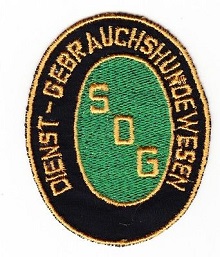
SDG Logo Thus, the SDG is granted greater freedom of movement and the centralized structure with regard to the inclusion in the GST has been abolished. Within the VKSK –as a state surveillance- institution– although she was accountable and also kept her educational mandate, to educate the members of the SDG to be socialist people; but she could now move more freely and act more independently. However, this did not apply to the SZG within the SDG. The SDG led the SZG even more closely and increasingly lost its influence on dogs- sports and dog breeding. In particular, the SDG –and not the SZG– was now again out for the- responsible for the organization of positions and events in the context of dog sports.
The selection of the performance judge candidates, their commitment to the entitlements, the appointment of the Leistungsrichter, the appointment protection for performance tests with the use of the Leistungsrichter was withdrawn from the SDG and carried out by the district and district administrations of the SDG. The bis- herige Leistungsrichterobmann der SZG thus became superfluous. The fact that the SDG had not completely abolished the SZG had only one reason, in the field of for breeding, the SDG lacked the competence that was almost exclusively present in the SZG. 2nd General Meeting of the SDG of 15.06.1968 As the highest body, the SDG receives a Presidium, which is elected at the General Assembly be.
The elected members of the Presidium (President, Vice-President, Secretary General, However, treasurer, etc.) must finally be confirmed by the VKSK. The subordinate lines of the SDG corresponded to the political structure of the GDR. There were 15 Districts, and in each district 10-15 districts. The district and district administrations were responsible to the Presidium subordinated to the SDG. The occupation of the lines at the district and district level was not technical criteria; the decision was based on the political attitude in the award these offices. The SDG was represented at the management levels and in the Presidium of the Stasi both in terms of personnel and enforced administratively. There were full-time and informal employees of the Stasi in the District and district administrations. The chairman of the Central Revision Commission of the SDG was a Officer of State Security.
Some of these management levels were after the reunification also active in management functions of the reunited breed dog associations. The most important publication of the SDG remains the magazine “Der Hund”, which is no longer published by the GST sonden is published by Deutscher Bauernverlag. Stamp of the SZG Schäferhunde The SDG paid special attention to the German Shepherd. Their goal was to breed well-trained, characteristic dogs around the police and other To equip the organs of the GDR and its “brother countries” with it. Since the membership numbers of the previous service breeds were not sufficient, further Dog breeds that are only remotely related to dog sports in the sense of a service and utility dog we had to deal with the SDG.
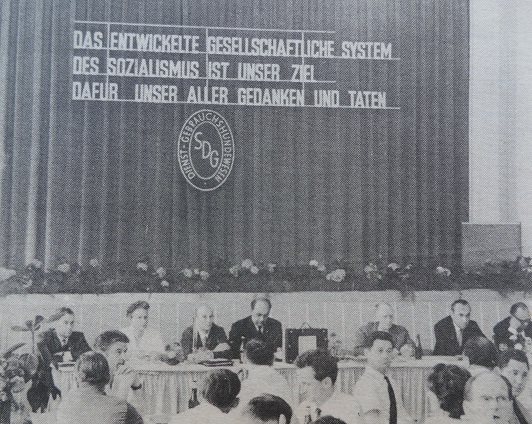
Thus, about 12 dog breeds were taken care of by the SDG, including in addition to typical service dogs, such as the German Shepherd and the Giant Schnauzer, there were also Great Danes, Dalmatians, Newfoundlanders, Landser etc.. New members could still be accepted directly from the local groups/basic organizations of the SZG and be looked after, but the membership fees went directly to the SDG. From there the funds requested by the SZG were distributed and approved. The SZG continued to criticize the support of the central SDG leadership. K.H. Traut- the SZG giant Schnauzer writes (The Dog 2/1963): “Just as in the previous year, the GDR winners’ exhibition of the Service Dog Training section was also in 1962 for a separate exhibition of the individual special breeding associations of the section. Neither in the preparation nor in the execution of this GDR victory show was an under- to feel the support of the central section management.”
The organizational shortcomings within the GST continued in the SDG. The SZG in the area of Service and service dogs were also on their own at the event of such major exhibitions. The distribution of tasks at the various levels of the SDG was unclear. The fluctuation, especially at the central level of the SDG, was significant and led to, that the structure and organization had not yet consolidated. Within the SDG there was a central breeding registry in which all SDG breeds were recorded centrally be. The studbook office was established in the 60s in Halle-Kreuzvorwerk. litter- entries, offspring assessments, breeding suitability tests, licensing, written inquiries and applications for kennel protection were received very quickly and structured processing.
The breeding of service and working dogs for export was continuously increasing. demand at the beginning of the 60s, it was no longer possible to cover from abroad. The litter numbers were included in the annual plans that planned the economic performance of the GDR. The food supply for the dogs was also still a problem in the early 60s. Fodder meat was allowed to be used only in trout and noble fur breeding. dog- athletes in the former GDR, there was no huge feed and accessories industry to stand by. A lot had to be improvised or handmade. For the most part, meat was fed , Oatmeal and vegetables, as well as what was left of their own food.
The forage meat supply was then included in the central annual planning in 1963; but could not- sufficient quantities of dry or canned food are produced. Sports facilities and orphanages were mostly created on their own, which was the reason for the dog athletes, because Lack of building materials, demanded a high level of improvisational talent. The dog sportsmen were in their sections, they were local, i.e. they could not easily switch between the local groups/reason- organizations (GO) switch back and forth. The visit of competitions outside the respective location had to be organized, because for the dog sportsmen only the common arrival by truck or train was possible.
Want if you left the district with the dog, the dog had to be introduced to an official veterinarian first be. Since the dog sport was organized by the state, one was released from the work- place. The dog sportsmen often became missions for the preservation of public order and security (e.g. to secure railway stations at football matches). Plenty the dog sportsmen were with the police or auxiliary police. The requirement for a service dog was clearly formulated: (Der Hund 4/1966): “He must protect his handler, if necessary. This requirement is based on good sharpness, Hardness, existing protective instinct, simply because he is supposed to bite.
A next requirement is a good nasal predisposition, which is due to the development and former living conditions the dog is present. Of course, the sensitivity of the olfactory organs is different. Other requirements are good handling when used as a guide dog for the blind or when- it’s a custom for the herd.” The dog should have a “use value”. This use value was in the first place and was constantly checked in the context of dog sports and dog breeding. The criticism was directed increasingly, a non-practical education. The examination regulations should be amended to include the Adapt the training accordingly.
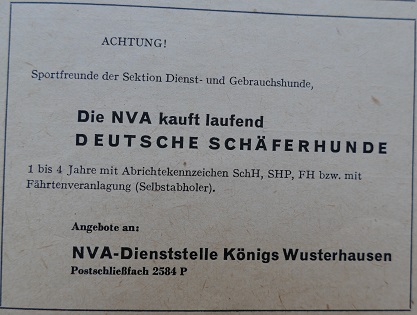
For this, the former GDR main kennel keeper for German Shepherds Werner Dalm wrote: “The Eastern German Shepherd became the largest part for our members, breeders and lovers bred. Only everything that we could not use for breeding was handed over to the police, border etc. are offered. In this respect, they only got the scum. However, these dogs had to be well bite and be good in essence, otherwise they were not taken….. Not the most special breed- the GDR was formed paramilitary, but the umbrella organization, the SZG, was the section Service and Utility Dogs (SDG) was subordinated, especially the last one.
The SZG was just tolerated, because the ‘above’ (stasi-controlled) had no idea about breeding, did you still need the SZG. But as the umbrella organizations had developed, the They took away one right after another. In the last few years, we have hardly had any information about our own race what to say.”
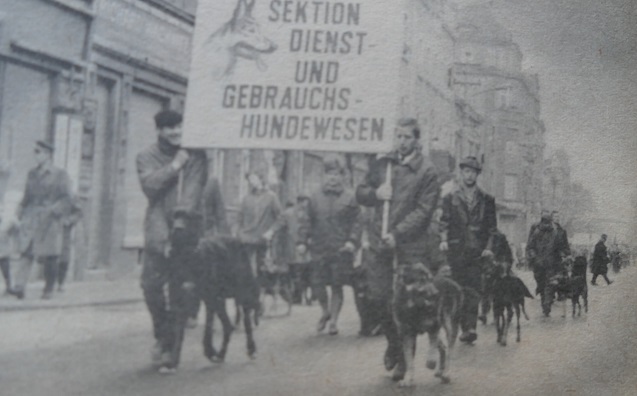
Participation of the SDG dog athletes in the May demonstration 1970 Thus, at the beginning of the 70s, the SDG also assigned the last responsibilities of the SZG to to withdraw and centralize (Der Hund 6/1973): “In the future, the SZG will no longer face problems of organization, contribution collection, with Educational measures or with the organization and implementation of events on employment- but can devote all their strength to the quantitative and qualitative development of use of their breeds. All supervisors work in the ‘ZFK special breeding associations’ and all The main breeding station in the ‘ZFK breeding’. There you will receive guidance and support, advice together with the other SZG about necessary measures of more effective breeding activity. In in the course of socialist community work, draft resolutions are being prepared for the Presidium, He- exchanged experiences and controlled stipulations.”
The basic organizations (GO) – comparable to local groups – were the basis of the SZG. After the Every member of the SDG could register for a GO regardless of which dogs- he had a race. The resistance of the GO for Dobermans and German Shepherds against this, also To include owners of other breeds in the GO, was approved by the district and Berziksleitungen, the now they were responsible for the GO, broken with the argument of the SDG: “At the center of our Work is about the person and not the dog”. The GO was diluted as a result and was no longer specifically to be assigned to a dog breed or a SZG, which was still set up in a breed-specific way. The contact of the SZG with the GO was also cut off, because the contribution payment and the community- cation is now only in direct exchange between GO and SDG or their district and district lines place.
It was no longer clear what task the SDG still had. In comments there is talk of “specialist institutions” and the attention to “breeding problems”. With effect from 01.01.1974, the last independence of the SZG was thus taken away. In 1974, the SDG had about 23,000 members. The goal of the SDG in the context of dog sports or breeding adapted to the new- in the right direction. In the 70s, the keeping of dogs became more and more popular. But it had to furthermore, the usefulness aspect from the point of view of socialist governance will be fulfilled. This It now consisted in the fact that the “working people” could relax with the dog in their free time, so that they could show good performances in the “enterprises” of the GDR.
Thus, the usefulness of- satisfying an aspect of the GDR on the subject of the dog; Der Hund 3/1977: “We will achieve this task (the SDG is meant), based on the initiative and drive of the Members of our organization realize responsibly. But there is also a The political-ideological work of our members in the management of our organization- in preparation for the 4th General Assembly, the growing socialist consciousness, the higher social activity and the socialist sense of community of the members in to promote all basic organizations in such a way that increasingly our sports friends in their free time in the realization of your versatile personal interests and inclinations in breeding- find a good rest and a high-level relaxation in the technical and dressing activities and thus gain new strength for the work in their companies and facilities and that they at the same time, socially useful in the community of the basic organization in their free time Doing work.” It must be useful !
The magazine of the SDG “The Dog” was also full of political , Agitation, which had rather little to do with the subject of the dog. Thus, the Vietnam War, which The construction of socialism, the “Bonn unjust state”, the “aggression” of Israel against Arab States and the recognition of the GDR as a sovereign state are discussed in detail in “The Dog”. The Dog 1/1974: “The pedigree dog breeders of our republic declare in protest resolutions on the war in Vietnam, the military coup in Chile and Israel’s aggression against Arab states Position.
They practiced active solidarity by following the call of the breeding commission about 2,000 Marks transferred to the solidarity account.” The educational mission of the SDG to convey the benefits of socialism was also in the 80s An essential part of dog sports in the GDR (Der Hund 3/1981): “A decisive concern of equally high growing political-ideological work of a radio- it must be important to discuss the advantages and values in a political conversation with our sports friends socialism and its infamy over the misanthropic system of capitalism to become conscious again.” With the fall of communism in 1989, there were also discussions about the future of the SDG. At the Presidium- meeting on 16.12.1989 criticism was expressed about the methods of management style, regulations, Incompetence and poor financial work of the SDG leadership.
Trust in the old leadership was at the low point. The SDG Presidium resigned and a working secretariat was to work out a sustainable concept for the future until the next Extraordinary General Meeting of- collection. The first ideas for organizational change were the formation of an independent cynological Organization in the GDR, which should be cooperatively affiliated to the VKSK. They were the same- permanent clubs with breed-specific breeding or dog sports tasks are provided. However, soon the SDG should completely break away from the VKSK and become independent. In parallel, the the SGSV – Schutz- und Gebrauchshundesportverband was founded.
The leadership of the new GDR organization should be taken over by specialists and not party cadres. It individual independent breed dog clubs should be founded again. The discussions on Reorientation At the beginning of 1990, more and more attention was paid to how the previous Structures can be transferred to new forms of organization. The old management levels and Officials no longer had so much to say about this. The previous regulation of the ZTP and new centrally available standard interpretations, and personally, due to the incapacitation as a petitioner and applicant was no longer accepted. The first proposals were not to found a new specific GDR organizations but the To integrate the organization into the existing breed dog clubs of West Germany have always been growing louder. The SDG existed until 13.01.1990.
3. The offspring assessment and the worm code system in the GDR At the beginning of the 50s, the SZG Schäferhunde introduced the offspring assessment (NCB). In the course of the following years, this NCB was also introduced for all other SZG; e.g. SZG German poodle breeders (since 01.01.1970) or SZG German Quail dogs (since 1958). The use of the offspring assessment assumes that for breeding the offspring just as important as the proof of descent is. In the offspring, which are among different Growing up, it becomes obvious what is hereditary and not hereditary.
The males more often than bitches are used, they also have more offspring, from which then the hereditary shares can be derived with a higher degree of certainty. When the dog is under- different bitches, its hereditary value, i.e. the components that the male with a high probability of being inherited, very accurately identified. The breeding selection takes place on the basis of the offspring of the male. This will pay attention to certain improvements or deterioration, because there are breeding animals that are suitable for generating an improvement for one characteristic and a deterioration for another characteristic.
The decisive factor in this method is the phenotype of a dog and its offspring, since too little is known about the genotype. Only by the phenotypic assessment of the breeding animals and their descendants can be traced back to the genotype. Every dog with a minimum age of 9 months was used in the GDR for the offspring assessment- considered. The established standard, the dogs should be close to a certain predetermined standard- and health (in the GDR, attention was paid here to HD, premolar losses, pigment deficiencies and The breeding animals were measured on the basis of the assessment of the offspring. The GDR started at the beginning of the 50s with the training of offspring evaluators in order to to qualify them for the offspring assessment (NCB).
The function and ability of a the breeding judge was a precursor to the breeding judge. The best offspring evaluators were then trained as a breeding funnel. In order to present as many offspring as possible at the NCB events, there were the pedigree of these dogs only after they have visited such an NCB. As long as there was only a registration certificate; but no pedigree:
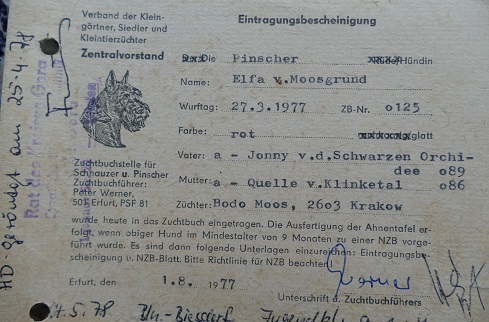
Read More: German Shepherd Dogs DDR History Page 4
Source: wallenfels-pinscher
